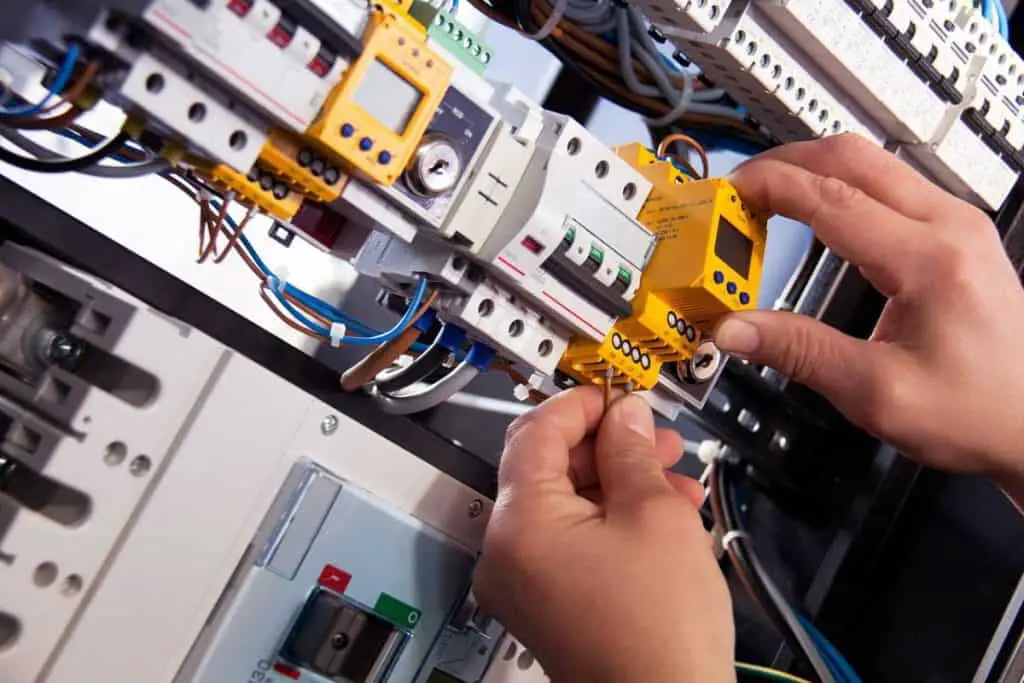
We receive lots of questions from our readers about how to deal with electrical overload and circuit breakers that suddenly disarm. So, we put this post together to try to answer the most common ones in one place.
How to identify electrical overload?
It is likely that you have already seen signs of electrical overload. It is common to see circuit breakers that frequently and suddenly switch off. You may also have seen that lights suddenly go off, or connections in electrical appliances get warm. These are all signs of electrical overload.
Also watch out for many electrical appliances connected to one electric circuit, directly or via an extension cord. This is where the problem usually starts. Let’s learn more now.
What to do when a circuit breaker switches off frequently?
In this situation, the best approach is to hire an electrician to study the electrical schema at your hours or apartment, and/or inspect the installation on-site to identify the problem.
In such rather complicated cases, it is always best to hire a professional (an architect or an engineer, or an electrician) to tackle the problem.
Read also: Why hire an architect for a renovation project? How much does it cost? – in this article. And, How not to waste time and resources on a renovation project? – in this article.
Therefore, when you see that a circuit breaker switches off the circuit all the time, it does not make any sense to change it for another one that supports higher currents. If you do this, you are inviting danger. If a circuit-breaker does not disarm anymore, as it used to do, it can even start a fire!
Moreover, the replacement of a circuit-breaker goes along with other interventions in the entire electrical installation such as replacing electrical wires and cables that are more suited for the goals that you are trying to achieve with this change.
What to do to prevent the circuit breaker from switching off?
In other words, in order not to overload the electrical circuits and make the circuit-breaker disarm, do the following:
Have proper electrical design done
Have a proper electrical design done, providing a good amount of sockets/circuits. This prevents the need to have splitters and extensions in order to plug a lot of equipment into the same power outlet.
It is important to provide separate circuits and circuit breakers for powerful equipment such as air conditioning, fridge, shower, dryer, washing machine`, kitchen stove, etc.
Install a central electrical board
It is also important to have a well-planned central electrical board. This helps to easily find equipment that is connected to a certain breaker and be able to identify and fix the issues.
Have certified circuit breakers in place
Don’t forget to provide/install quality circuit breakers with proper certification that compatible with what they are going to be used for.
Use suitable wiring
In addition, it is necessary to use wiring with suitable gauges and compatible with the intended use and installed circuit breakers.
Does wiring have an expiration date?
Electrical wiring does age. The insulation layer tends to dry (hello short circuit!). If electric wiring is under constant overload the aging and drying tend to go faster.
The properties most subject to overload are those over 15 years of age.
It is ideal is to plan a preventive review/maintenance review with a qualifies professional every 5 years of use.
Read also: How to properly plan a renovation project? and avoid troubles – in this article. And, How to plan on a limited budget? – in this article.
Can air conditioning cause electrical overload?
Yes, air conditioning is a device that consumes a lot of electrical power and can cause electrical overload.
Overheating and electrical overload can happen for several reasons:
- at the construction phase or during the installation of the air conditioner the electrical wiring was not designed to hold electrical loads compatible with the device or
- there was no preparation of the installation to receive so much power; and
- there must be a circuit breaker and an exclusive circuit for an air conditioning unit.
Therefore, before buying an air conditioner for your home or office, it is necessary to evaluate the power of the electrical network of the room, for which you will use this air conditioner and prepare the necessary electrical wiring to be able to accommodate this device.
Read also: What needs to be done prior to installing air conditioning? – in this article. And, How to plan the right number of electric sockets? – in this article.

A circuit breaker disarms very often. What to do?
A circuit breaker is a safety device that disarms every time its capacity is exceeded. It disarms to interrupt the electric current and prevent overheating, which could start a fire. A circuit breaker has the same function as a fuse. But a fuse blows and then it is necessary to replace it with a new one. A circuit breaker has a spring that disarms the circuit, then it is enough to switch it on again, without having to change any of its parts.
The most common reason
The most common reason for a circuit breaker to disarm is the overload of the electrical system.
This is very common in older homes because they are not designed to connect so many appliances that demand high power. Or the circuit may be overloaded due to the installation of new equipment with higher power than what was foreseen in the project (for example, a very powerful microwave machine or a fridge). Then the only way is to replan your electrical network.
How to resolve
If your central electrical power board still uses fuses, it is best to switch to safer circuit breakers and get new cables.
If you prefer to place a circuit breaker that will withstand a larger amperage, you will also need to change the wiring. Otherwise, if, for example, you use a 30A circuit breaker with 15A wiring, the wires will overheat, but the circuit breaker will not switch off and this may lead to a short circuit!
When changing your wiring, always think of the circuit breaker + wiring set. The most commonly used wires in residential electrical circuits are:
| Wire diameter | Current |
| 1.5 mm² | 15.5 amps |
| 2.5 mm² | 21.0 A |
| 4.0 mm² | 28.0 A |
| 6.0 mm² | 36.0 A |
| 10.0 mm² | 50.0 A |
Other possible reasons
Poor connection or insulation
The circuit breaker connection to the electrical wiring may be not well insulated or loose. To solve this issue, you will need to re-set or to isolate the connection again, so that the circuit breaker can be in operation again. It may make sense to call for an electrician to do this work for you.
Defective equipment
It may be that some equipment is defective, causing leakage of current. This causes overheating and the circuit breaker disarms. Check out all appliances and see if this could be the reason.
Wiring in old buildings
In old buildings, the problem may be in how the wiring was originally done. It could often be undersized for the current power requirements that need to pass through it.
If you live in an old building, the problem may be outside of your apartment. It may be that the cable that comes from the lower floor and carries power to all the apartments is not adequately sized and disarms the general breaker of the building.
To solve this problem, it will be necessary to change the thickness (gauge) of the wires of the building. Hence, all residents of the apartment building or those residents, who are interested, will be responsible for the renovation.
This project will need to exchange electrical cables for ones of greater thickness. Calculation and design of this work must be done by an electrical engineer.
Still, first, make sure the electrical installation of your apartment is well done. Call an electrician or electrical engineer to evaluate.
Circuit breaker disarms in the middle of a warm bath
The most common reason
If you are using an electric shower in your house, this means that the power of the shower is greater than the wiring (thickness) can hold. To prevent wires from heating and shorting the circuit breaker disarms.
In fact, the circuit breaker disarms and interrupts the electric current as a safety feature to prevent overheating, which can cause a fire. The bath is cold, but the house is safe.
Other possible causes
It may also be that there is poor contact at the connection between the circuit breaker and the electrical wire of the circuit that turns on the shower.
Or the shower disarms the circuit breaker because the shower is connected via an existing power outlet, not a dedicated one. Most standard power outlets are made to take 15A of current and new showerheads are often designed to take not less than 25A.
How this could be avoided
The best thing would be to check, before buying an electric shower and see if the power of the shower is compatible with the circuit breaker amperage. For example, if you have a 30A circuit breaker you have to buy a shower of max. 6,600W (30A * 220V = 6,600W). The electric power of the shower is usually mentioned on the packaging.
Or, if you really want a hotter bath, you could change the circuit breaker and the wiring that goes to the shower (use thicker wiring that allows higher current).
It is also important to be aware of the wiring that is made to connect the shower wire to the electrical system of the house. This connection must be tight, well-insulated and not used any plugs.
In addition to the above, make sure that the grounding is well done. This will help avoid shocks.


